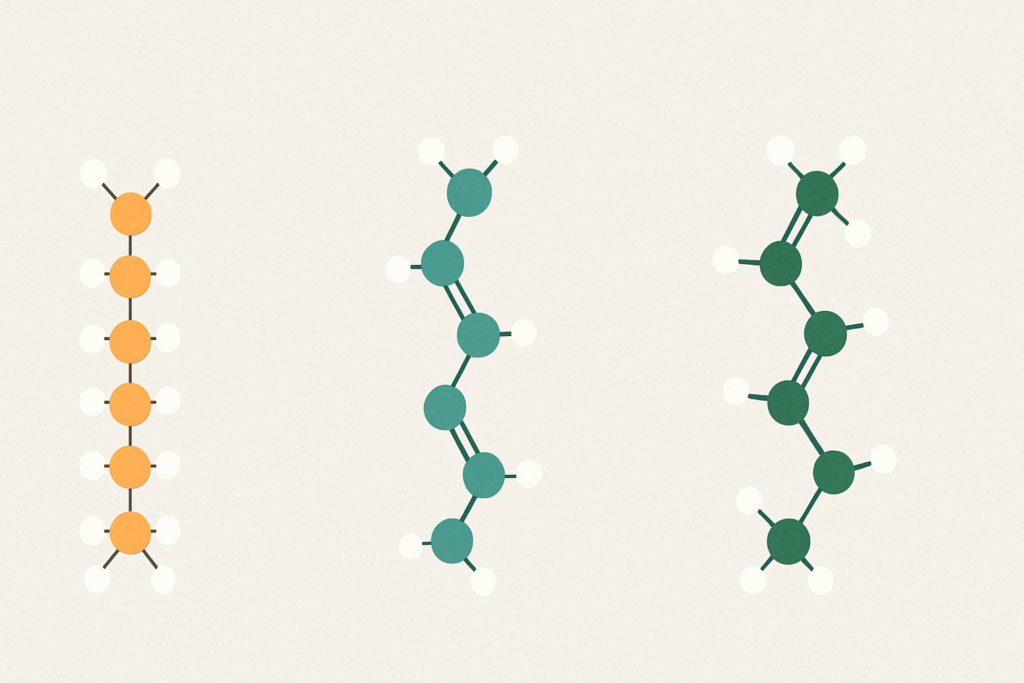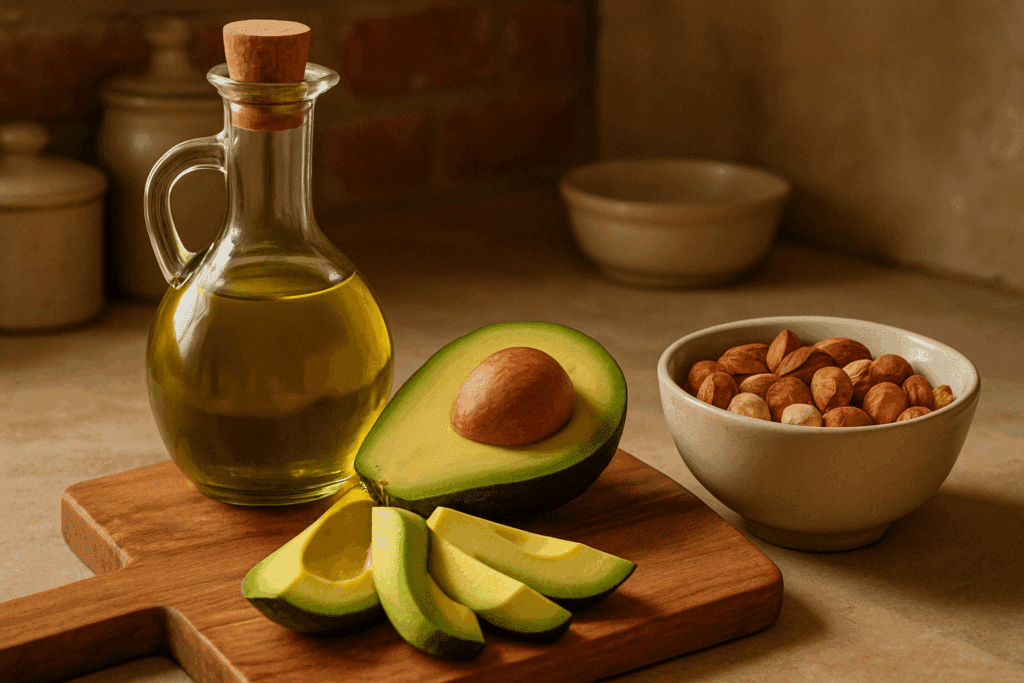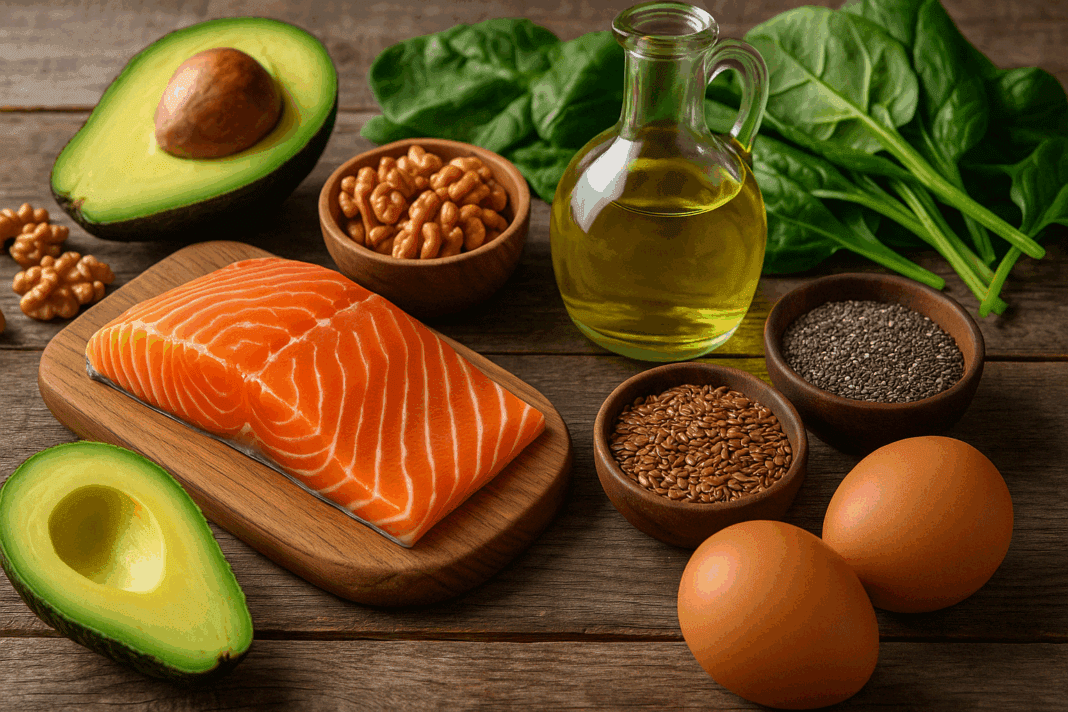Introduction: Understanding the Role of Fatty Acids in Human Health
Fatty acids are among the most talked-about nutritional components in modern health discourse, yet they remain poorly understood by many people outside the fields of medicine and nutrition. With the rise of chronic health conditions such as cardiovascular disease, diabetes, and obesity, understanding how dietary fats contribute to overall wellness has become increasingly important. The question “what are considered fatty acids” is far more than academic; it’s foundational to making informed dietary choices that support heart health, cognitive performance, and cellular function. In this article, we will unpack the biochemistry of fatty acids, explore their classifications and health implications, and discuss what type of foods have good fatty acids to help you build a diet that supports long-term well-being.
You may also like: Macronutrients vs Micronutrients: What the Simple Definition of Macronutrients Reveals About Your Diet and Health

Defining Fatty Acids: The Molecular Foundation of Fats
To begin with, fatty acids are the building blocks of fats in our diets and in our bodies. Chemically speaking, they are long chains of carbon atoms bonded to hydrogen atoms, ending in a carboxyl group. Their structure may seem abstract, but it determines everything about how they behave in the body. Fatty acids fall into three primary categories: saturated, monounsaturated, and polyunsaturated. Each of these plays a distinct role in the body, and understanding their differences is essential for grasping how fat consumption influences health. Trans fats, often categorized separately due to their artificial production and harmful effects, further complicate the picture. So when asking what are considered fatty acids, it’s essential to look beyond the word “fat” and dig into the science of how these molecules operate in our physiology.
Saturated Fatty Acids: Reconsidering Their Place in the Modern Diet
Saturated fatty acids, typically solid at room temperature, are most commonly found in animal products like butter, cheese, and red meat. These fats have been historically linked with an increased risk of heart disease because they can raise levels of LDL cholesterol, sometimes referred to as “bad cholesterol.” However, not all saturated fats are created equal, and emerging research suggests that some types, like those found in coconut oil and certain dairy products, may not be as harmful as once believed. Still, moderation is key, and replacing some sources of saturated fats with healthier alternatives is a widely recommended strategy.

Monounsaturated Fatty Acids (MUFAs): The Heart-Healthy Choice
Monounsaturated fatty acids (MUFAs), on the other hand, are generally considered beneficial for cardiovascular health. Found in foods like olive oil, avocados, and certain nuts, MUFAs have been shown to help lower LDL cholesterol while increasing HDL cholesterol, often dubbed the “good cholesterol.” These fatty acids are also rich in antioxidants and anti-inflammatory properties, making them ideal components of a heart-healthy diet. When people ask what type of foods have good fatty acids, these MUFA-rich options frequently top the list because of their favorable health profiles and culinary versatility.

Polyunsaturated Fatty Acids (PUFAs): Essential Fats for Brain and Body
Polyunsaturated fatty acids (PUFAs) are another important group, which includes omega-3 and omega-6 fatty acids. These are essential fats, meaning the body cannot synthesize them and they must be obtained from dietary sources. Omega-3 fatty acids, found in fatty fish like salmon, flaxseeds, and walnuts, have potent anti-inflammatory effects and are crucial for brain function, eye health, and heart disease prevention. Omega-6s, found in vegetable oils and processed foods, are also necessary in small amounts, but their overconsumption can lead to inflammation. Balancing the intake of omega-3 and omega-6 is critical to harnessing the benefits of PUFAs without exacerbating inflammatory pathways.
Fatty Acids at the Cellular Level: Why They Matter Beyond Calories
Fatty acids are not just important for cardiovascular and brain health—they are also integral to the function of every cell in the body. Cell membranes are composed largely of phospholipids, which contain fatty acids that determine the fluidity and permeability of the membrane. This, in turn, affects how well nutrients enter cells and how effectively waste products are removed. Moreover, fatty acids play roles in hormone production, gene expression, and immune response. Thus, understanding what are considered fatty acids and incorporating the right types into your daily intake is more than a matter of diet—it’s a matter of cellular vitality.
Foods Rich in Fatty Acids: More Than Just Fish and Oils
When evaluating fatty acids foods for daily consumption, one must consider not only the type of fatty acids present but also the food’s overall nutrient profile. For instance, fatty fish like salmon and mackerel provide high-quality protein alongside beneficial omega-3s, making them a doubly valuable addition to the diet. Similarly, nuts and seeds offer fiber, magnesium, and plant-based protein in addition to their fatty acid content. Choosing foods that offer a synergy of nutrients is key to optimizing health outcomes and achieving a balanced intake of beneficial fats.

The Mediterranean Diet: A Model of Healthy Fat Consumption
The Mediterranean diet is often cited as a model for healthy fat consumption, largely because it emphasizes foods that are rich in monounsaturated and polyunsaturated fats. Olive oil, a central component of this dietary pattern, is particularly rich in oleic acid—a monounsaturated fat with strong anti-inflammatory and cardioprotective properties. When researchers discuss what type of foods have good fatty acids, olive oil is consistently among the top choices due to its wealth of clinical evidence and traditional use in health-promoting cuisines. The same applies to oily fish, nuts, and seeds, all of which feature prominently in Mediterranean dietary patterns.
Plant-Based Sources of Healthy Fatty Acids
For plant-based eaters, it’s entirely possible to obtain ample fatty acids foods without consuming animal products. Flaxseeds, chia seeds, hemp seeds, and walnuts are all excellent sources of alpha-linolenic acid (ALA), a plant-based omega-3 fatty acid. While the body can convert ALA into the more potent forms EPA and DHA, the conversion rate is relatively low. Therefore, some individuals may benefit from algae-based omega-3 supplements to meet their needs. Nonetheless, a well-planned plant-based diet can provide a rich array of fatty acids, alongside fiber and antioxidants that further support wellness.
The Problem with Processed Fats and Trans Fatty Acids
Not all fats marketed as healthy truly align with nutritional science. For example, many processed foods claim to contain vegetable oils, but these often include refined versions high in omega-6 fatty acids, which—when consumed in excess—may contribute to chronic inflammation. It’s important for consumers to read labels carefully and prioritize whole food sources of healthy fats. Cooking oils should ideally be cold-pressed and unrefined, and when possible, meals should be prepared at home using minimally processed ingredients. These strategies help ensure a better balance of fatty acids and reduce the intake of trans fats and other harmful compounds.

Fatty Acids in Special Populations and Clinical Nutrition
In children and adolescents, fatty acids play a crucial role in growth and neurological development. DHA, in particular, is vital for the formation of neural tissue and the retina. Pregnant women are often advised to consume adequate amounts of omega-3s to support fetal brain development, and numerous studies underscore the link between maternal fatty acid intake and improved cognitive outcomes in offspring. This highlights another dimension of the importance of understanding what type of foods have good fatty acids—especially during critical life stages where nutritional demands are heightened.
Fatty Acids as Therapeutic Nutrients
In clinical nutrition, fatty acids are often used therapeutically. Patients with inflammatory conditions such as rheumatoid arthritis, for example, may benefit from high-dose omega-3 supplementation. Similarly, individuals with hyperlipidemia might be prescribed diets rich in MUFAs and omega-3s to help manage cholesterol levels. These interventions are grounded in rigorous research and demonstrate how dietary fats can serve not only as preventive agents but also as tools for managing disease. The phrase “fatty acids foods” takes on new significance in such contexts, as the right types of fats can meaningfully improve health outcomes when integrated into a comprehensive care plan.
Public Health and the Evolution of Dietary Guidelines on Fats
Dietary guidelines have evolved significantly over the years, moving away from fat phobia and toward a more nuanced understanding of how different fats affect the body. Current recommendations encourage the replacement of saturated fats with unsaturated alternatives and emphasize the inclusion of whole foods rich in essential fatty acids. Public health initiatives have increasingly focused on educating consumers about label reading, food sourcing, and culinary practices that support a healthier fat profile in everyday meals. As knowledge spreads, so too does the ability for individuals to make empowered dietary choices rooted in science and sustainability.
Environmental Considerations of Fatty Acid Sources
Furthermore, the environmental impact of different fat sources is an emerging area of concern. While fish are excellent sources of omega-3s, overfishing and marine pollution raise ethical and ecological questions. Plant-based sources, including algae-based omega-3 supplements and sustainably farmed seeds and nuts, offer viable alternatives. Understanding where our fatty acids come from and how their production affects the planet adds another layer to the question of what are considered fatty acids in the context of responsible consumption.
Frequently Asked Questions (FAQ) – Fatty Acids and Your Health
1. How can someone assess whether they’re getting enough good fatty acids in their daily diet?
Assessing whether your diet provides enough healthy fats begins with looking at both variety and source. Many people unknowingly consume an excess of omega-6-rich oils found in processed foods while falling short on omega-3s. One of the most practical ways to check your intake is by tracking how often you eat known fatty acids foods like salmon, chia seeds, and walnuts throughout the week. Functional nutritionists may also recommend omega-3 index blood testing to identify deficiencies. If you’re unsure what are considered fatty acids with health benefits, a diet focused on whole foods—rather than supplements alone—often provides better bioavailability and long-term outcomes.
2. What are some overlooked or unconventional sources of good fatty acids that most people don’t include in their diets?
While many individuals rely on popular sources like olive oil or salmon, there are lesser-known foods rich in beneficial fatty acids that deserve more attention. Seaweed, for instance, is a marine vegetable that provides a form of omega-3 that can be especially valuable for those on plant-based diets. Another example is pasture-raised eggs, which contain significantly higher levels of omega-3s than conventional eggs. Full-fat plain yogurt from grass-fed cows can also be a surprising but effective source of fatty acids foods. When exploring what type of foods have good fatty acids, don’t overlook these unique, nutrient-dense options that can diversify and strengthen your nutritional profile.
3. How does the way we cook food affect the integrity of fatty acids?
Cooking methods have a direct impact on the chemical stability of fatty acids. For example, high-heat methods such as frying can oxidize healthy fats, turning them into harmful compounds. This is particularly true for polyunsaturated fats, which are more heat-sensitive than monounsaturated ones. Cold-pressed oils like flaxseed and walnut oil are best used raw in dressings or drizzled over food. If you’re serious about maintaining the nutritional value of fatty acids foods, favor gentle cooking methods like steaming, baking, or light sautéing with stable oils like avocado or extra virgin olive oil.
4. Can the balance of fatty acids in the diet affect mental health or mood?
Emerging research strongly supports the link between dietary fats and brain health, particularly concerning mood regulation and cognitive clarity. A deficiency in omega-3 fatty acids has been correlated with higher risks of depression and anxiety, while a more balanced fatty acid ratio can support neurotransmitter function and inflammation reduction in the brain. This connection is especially important when evaluating what are considered fatty acids critical to emotional wellness. Including fatty acids foods like mackerel, sardines, and walnuts on a regular basis may not only benefit your physical health but also contribute to better emotional resilience and mental performance over time.
5. Are there any populations or age groups that need higher intakes of healthy fatty acids?
Yes, different life stages come with unique fatty acid requirements. Pregnant individuals need higher levels of DHA to support fetal brain and retina development. Young children also benefit greatly from omega-3s, as these are critical for neurodevelopment during early childhood. Meanwhile, older adults may need more anti-inflammatory support from omega-3-rich fatty acids foods to manage chronic inflammation and cognitive decline. Knowing what type of foods have good fatty acids at each life stage allows for tailored nutrition that meets changing physiological needs.
6. What is the significance of fatty acid diversity in a person’s overall nutritional strategy?
Just like a diverse microbiome enhances gut health, a diverse intake of fatty acids supports more holistic bodily functions. Focusing solely on omega-3s or MUFAs without considering a balance of various essential fatty acids can limit their synergistic benefits. Diversity helps modulate inflammation, supports metabolic efficiency, and aids in the production of signaling molecules and hormones. Fatty acids foods should ideally include a mix of marine and plant-based sources to maximize this spectrum. Expanding your understanding of what are considered fatty acids allows for a more dynamic, personalized approach to health.
7. How does food processing impact the fatty acid profile of everyday items like snacks or oils?
Food processing, particularly refining and hydrogenation, often depletes or distorts the natural fatty acid composition of oils and snacks. When oils are heavily refined, they lose valuable antioxidants and are stripped of omega-3 content. Hydrogenated fats, found in many shelf-stable snacks, introduce trans fats, which are harmful to cardiovascular and metabolic health. This makes it essential to not only know what type of foods have good fatty acids but also to prioritize minimally processed versions of those foods. Always read labels for hydrogenation and opt for cold-pressed or unrefined oils when possible.
8. Can athletic performance or recovery be influenced by fatty acid intake?
Absolutely. Fatty acids play a key role in cellular energy production, muscle repair, and inflammation modulation—all essential aspects of athletic performance and recovery. Athletes often focus on carbohydrates and protein, but strategic inclusion of fatty acids foods like fatty fish, chia seeds, and high-quality oils can significantly enhance endurance and reduce post-exercise soreness. Omega-3 fatty acids, in particular, may support improved oxygen efficiency and heart rate regulation during exertion. Those who understand what are considered fatty acids valuable for recovery can fine-tune their diets for better performance gains.
9. How does climate-conscious eating relate to fatty acid consumption?
As awareness of sustainability grows, so does interest in the environmental footprint of our dietary choices, including fats. Fish farming and overfishing raise concerns about marine ecosystems, while industrial oil crops can lead to deforestation and habitat loss. Incorporating more sustainable fatty acids foods—such as algae-based omega-3s or locally sourced flaxseeds—can align health goals with environmental stewardship. This adds another layer of value to understanding what type of foods have good fatty acids: it’s not just about nutrition, but also ethics and planetary health.
10. What are practical tips for increasing good fatty acids without increasing total calorie intake too much?
Balancing fatty acid intake without excess calories requires intentional substitutions rather than simple additions. For instance, swapping low-fat salad dressings with a drizzle of extra virgin olive oil enhances both taste and nutrition without overloading your plate. Replacing refined snacks with a handful of walnuts or seeds is another smart way to boost your intake of fatty acids foods. Understanding what are considered fatty acids helpful for health can guide these decisions, especially when you prioritize quality over quantity. Ultimately, integrating fats mindfully into meals can elevate both their flavor and functional health benefits without tipping the calorie scale.
Conclusion: Building a Fatty Acid-Rich Diet for Long-Term Health
In summary, developing a deeper understanding of fatty acids involves more than just memorizing categories—it requires recognizing the biological functions they serve, the health benefits they confer, and the best dietary sources available. From supporting cardiovascular health to enabling cellular communication and hormonal balance, fatty acids are indispensable components of human nutrition. The foods that provide these nutrients—ranging from wild-caught salmon to organic flaxseed—are as varied as they are valuable. Knowing what type of foods have good fatty acids empowers individuals to craft diets that support vitality, resilience, and longevity. And in doing so, the phrase fatty acids foods becomes more than a label; it becomes a cornerstone of preventive health.
The journey to better health starts with the choices we make at the grocery store and in our kitchens. By prioritizing high-quality sources of fatty acids and understanding the roles they play in the body, we can take a powerful step toward reducing the burden of chronic disease, enhancing mental clarity, and improving our overall quality of life. It’s not about fearing fat—it’s about choosing the right kinds, in the right amounts, from the right sources. And when we ask what are considered fatty acids, the answer becomes a guide to smarter, science-backed nutrition that stands the test of time.
Further Reading:
Fatty Acid Types and Food Sources


